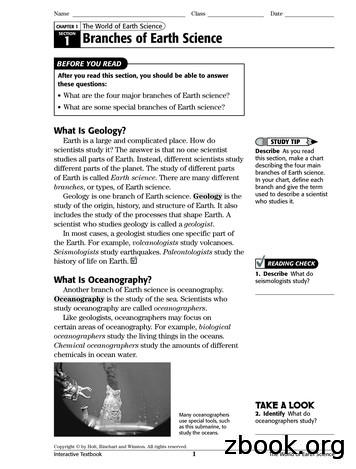1 SECTION 1 Branches Of Earth Science
NameCHAPTER 1ClassDateThe World of Earth ScienceSECTION1 Branches of Earth ScienceBEFORE YOU READAfter you read this section, you should be able to answerthese questions: What are the four major branches of Earth science? What are some special branches of Earth science?What Is Geology?Earth is a large and complicated place. How doscientists study it? The answer is that no one scientiststudies all parts of Earth. Instead, different scientists studydifferent parts of the planet. The study of different partsof Earth is called Earth science. There are many differentbranches, or types, of Earth science.Geology is one branch of Earth science. Geology is thestudy of the origin, history, and structure of Earth. It alsoincludes the study of the processes that shape Earth. Ascientist who studies geology is called a geologist.In most cases, a geologist studies one specific part ofthe Earth. For example, volcanologists study volcanoes.Seismologists study earthquakes. Paleontologists study thehistory of life on Earth.STUDY TIPDescribe As you readthis section, make a chartdescribing the four mainbranches of Earth science.In your chart, define eachbranch and give the termused to describe a scientistwho studies it.READING CHECK1. Describe What doseismologists study?What Is Oceanography?Another branch of Earth science is oceanography.Oceanography is the study of the sea. Scientists whostudy oceanography are called oceanographers.Like geologists, oceanographers may focus oncertain areas of oceanography. For example, biologicaloceanographers study the living things in the oceans.Chemical oceanographers study the amounts of differentchemicals in ocean water.TAKE A LOOKMany oceanographersuse special tools, suchas this submarine, tostudy the oceans.2. Identify What dooceanographers study?Copyright by Holt, Rinehart and Winston. All rights reserved.Interactive Textbook1The World of Earth Science
NameSECTION 1ClassDateBranches of Earth Science continuedWhat Is Meteorology?READING CHECK3. Define What ismeteorology?Meteorology is a branch of Earth science thatdeals with Earth’s atmosphere, especially weather andclimate. Scientists who study meteorology are calledmeteorologists.Many meteorologists try to forecast, or predict, theweather. In most cases, weather forecasts help to make ourlives more comfortable. Sometimes, meteorologists canhelp save people’s lives by predicting severe weather, suchas hurricanes and tornadoes. These predictions can warnpeople to leave an area before severe weather strikes.TAKE A LOOK4. Explain How canmeteorology save people’slives?These meteorologists are risking theirlives to gather information abouttornadoes. This information may helpother meteorologists better predictwhere and when tornadoes will strike.What Is Astronomy?Critical Thinking5. Compare What is themain difference betweenastronomy and otherbranches of Earth science?Astronomy is the study of the universe. Astronomersare scientists who study stars, asteroids, planets, and otherobjects in space.Most objects in space are very far away. Therefore,astronomers depend on technology to help them studythese objects. For example, astronomers may usetelescopes to study distant stars and planets.You may wonder why astronomy is a branch of Earthscience if astronomers study objects far from the Earth.The reason is that many astronomers use informationabout other planets and stars to learn more about theEarth. For example, some astronomers study ancient starsin the universe. The information they gather can help themto predict how changes in our sun may affect the Earth.Copyright by Holt, Rinehart and Winston. All rights reserved.Interactive Textbook2The World of Earth Science
NameSECTION 1ClassDateBranches of Earth Science continuedWhat Are Some Other Branches of EarthScience?Geology, oceanography, meteorology, and astronomyare the four main branches of Earth science. However,there are many other branches of Earth science.ENVIRONMENTAL SCIENCEEnvironmental science is the study of how humansinteract with the environment. Environmental scientistshelp people learn ways to preserve the environment and touse resources wisely.ECOLOGYEcology is the study of relationships betweenliving things and their environments. Ecologists studycommunities of organisms and their environments tobetter understand how organisms behave. Ecologists workin many fields, including agriculture and forestry.GEOCHEMISTRYGeochemistry combines the studies of geology andchemistry. Geochemists study the chemicals that makeup Earth materials such as rocks, minerals, and soil. Theycan use this information to learn how the Earth materialsformed. Geochemists may also study the effects of humanmade chemicals on the environment.READING CHECK6. Identify Give two thingsthat environmental scientistscan help people learn to do.Say ItDiscuss In a small group,talk about different jobs thatEarth scientists can have.Who may Earth scientistswork for? What kinds of workcould they do every day?TAKE A LOOKGeochemists maytake rock samplesand analyze themin a laboratory.7. Describe What dogeochemists study?GEOGRAPHY AND CARTOGRAPHYGeography is the study of the surface features ofthe Earth, such as continents, rivers, and mountains.Many geographers work in cartography, or map-making.Cartographers use information from photographs andcomputers to make maps. They may also study the waysthat areas change with time.Copyright by Holt, Rinehart and Winston. All rights reserved.Interactive Textbook3The World of Earth Science
NameClassDateSection 1 ReviewSECTION VOCABULARYastronomy the scientific study of the universegeology the scientific study of the origin, history,and structure of Earth and the processes thatshape Earthmeteorology the scientific study of Earth’satmosphere, especially in relation to weatherand climateoceanography the scientific study of the ocean,including the properties and movements ofocean water, the characteristics of the oceanfloor, and the organisms that live in the ocean1. List What are the four major branches of Earth science?2. Infer What kind of Earth scientist would most likely study thunderstorms?Explain your answer.3. Explain Why is astronomy a branch of Earth science?4. Compare How is environmental science different from ecology?5. Explain Why do astronomers depend on technology?6. Define What is geography?Copyright by Holt, Rinehart and Winston. All rights reserved.Interactive Textbook4The World of Earth Science
Earth Science Answer KeyChapter 1 The World ofEarth Science7. A controlled experiment is set up by a sci-entist to study one variable at a time. Whenscientists use observation to collect data,they cannot control the variables.SECTION 1 BRANCHES OF EARTH SCIENCE8.1. earthquakes2. oceans3. the study of Earth’s atmosphere, weather,4.5.6.7.and climateMeteorologists can predict severe weatherin time for people to get out of the way.Unlike other branches of Earth science,astronomy deals with the study of objectsand materials not found on Earth.Preserve the environment; use resourceswisely.the chemicals that make up Earth materials10.6.12.He made a table tocompare the shapes andsizes of his bones with thebones of known dinosaurs.Step in scientificmethodsHow did David Gilletteapply this step?Drawing conclusionsHe concluded that thedinosaur was a newspecies.Review1. The scientist can make observations about2.3.4.the fraction is about 0.06.2. a series of steps scientists use to answerquestions and to solve problems3. Answers will vary.4. a possible answer to a question5. Step in scientificHow did David GilletteHe thought that the bonescame from a new kind ofdinosaur.Analyzing resultsthem and determine whether they are reliable.1. Answers will vary. For a person 5 feet tall,Forming a hypothesisHow did David Gilletteapply this step?13. Sharing results allows other scientists to testSECTION 2 SCIENTIFIC METHODS INEARTH SCIENCEapply this step?Step in scientificmethodsresults can tell scientists that they are looking in the wrong spot or can point them innew directions.study weatherMany astronomers use information fromother bodies in the universe to learn moreabout the Earth and our solar system.Environmental science is the study of howhumans interact with the environment.Ecology is the study of how all organisms, notjust humans, interact with their environments.The objects they study are very far away, soastronomers use technology to see them.the study of the surface features of the EarthmethodsHe made manymeasurements of thebones.11. Answers will vary. In general, negativeoceanography5.Testing hypothesesdata2. a meteorologist, because meteorologists4.How did David Gilletteapply this step?9. to help them form explanations based on theReview1. astronomy, geology, meteorology,3.Step in scientificmethods5.the natural world and collect data from theobservations.Scientists ask questions to guide theirresearch. The questions help them to planexperiments that focus on the most important things they want to learn.Answers will vary but should be reasonable.Write a paper, give a talk, or publish on theInternet.Answers include: A scientist might sharehis or her findings several times. He or shemight repeat an experiment if the results arequestioned or to obtain more data.SECTION 3 SCIENTIFIC MODELS1.2.3.4.6. pieces of information gathered byexperimentation or observationto study very large or very small thingsa model that you can see or toucha model made of equations and dataComputers can do many calculations quicklyand accurately.Copyright by Holt, Rinehart and Winston. All rights reserved.Interactive Textbook Answer Key33Earth Science
Interactive Textbook Answer Key 33 Earth Science Earth Science Answer Key Chapter 1 The World of Earth Science SECTION 1 BRANCHES OF EARTH SCIENCE 1. earthquakes 2. oceans 3. the study of Earth’s atmosphere, weather, and climate 4. Meteorologists can predict severe weather in time for people to get out of the way. 5. Unlike other branches of .
Navy This branch of our nation’s armed services conducts military operations at sea, world-wide. According to the Department of Defense, its focus is “maintaining the freedom of the seas, deterring aggression, and achieving victory at war.” Like the Air Force, the Navy has many aircraft to assist with protecting the seas.File Size: 959KBPage Count: 12Explore furtherUnderstanding the 5 Branches of US Military - US Militaryusmilitary.comBasic Branches of the United States Armylibarts.hamptonu.eduU.S. National Military Chain-of-Commanddde.carlisle.army.milArmy Branches Military Science - SOU Homeinside.sou.eduWhat Are the Branches of the US Military? Military.comwww.military.comRecommended to you b
Thank you for purchasing my Branches of Government packet. This packet includes a few different activities you can use with your students to teach the branches of government. JIGSAW Divide your class into 3 groups. Give each group one of the branches of government pages (pages 2-4 in this pac
Acquisition of HSBC East Coast Branches & Online Deposits HSBC acquired branches MD PA VA NJ DE FL Pro-forma geographic footprint NY PA NH VA NJ ME WV OH DE MI VT MA CT MD RI HSBC Branches Acquired CFG Footprint New York Metro Southeast Florida Mid-Atlantic/D.C. Southeast Florida Source: SNL
Oct 01, 2019 · Rg Veda Yajur Veda Sama Veda Atharva Veda 21 Branches 109 Branches 1000 Branches 50 Branches Salvation - Salokya - Utter Lords Name. - Lords world - Sarupaya - Attains Lords form. - Samipya - Nearness to
Jul 18, 2016 · the first slice, the branches are not separated, so there is just one knot corresponding to the particle. In the next three slices, the branches are separated, and both of the branches have one instance of the knot. Because the branches are separated, the knots are independent of each other and can move independently.
Bridgit's Quilling Fir branches PDF Instructions Quilling Fir branches are on the 1st and 4th Image in direct compa rison to Original Fir branches
COMMON TO ALL BRANCHES B.Tech I year, II Semester (Common to all branches) SI. No. Course No. Subject Credits Teaching Schedule Hrs. LTP Total 1. PH -102T Engineering Physics -II (All Branches) 4 310 4 2. CY -101T Engineering Chemistry (CH, CS & ME) 4 310 4 3. MA -1
validated awards is a matter of prime importance to the OU. The OU will take any action it considers necessary under its Royal Charter to protect the quality of validated programmes of study and the standard of its validated awards. A1.6 Quality assurance As a UK University, the OU is subject to the requirements and expectations of UK higher education, as represented by the Quality Assurance .























